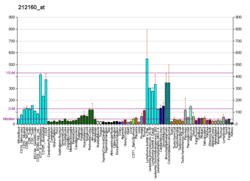Exportin-T is a protein that in humans is encoded by the XPOT gene.[5][6][7]
This gene encodes a protein belonging to the RAN-GTPase exportin family that mediates export of tRNA from the nucleus to the cytoplasm. Translocation of tRNA to the cytoplasm occurs once exportin has bound both tRNA and GTP-bound RAN.[7]
References
- 1 2 3 GRCh38: Ensembl release 89: ENSG00000184575 - Ensembl, May 2017
- 1 2 3 GRCm38: Ensembl release 89: ENSMUSG00000034667 - Ensembl, May 2017
- ↑ "Human PubMed Reference:".
- ↑ "Mouse PubMed Reference:".
- ↑ Kutay U, Lipowsky G, Izaurralde E, Bischoff FR, Schwarzmaier P, Hartmann E, Gorlich D (Jul 1998). "Identification of a tRNA-specific nuclear export receptor". Mol Cell. 1 (3): 359–69. doi:10.1016/S1097-2765(00)80036-2. PMID 9660920.
- ↑ Arts GJ, Fornerod M, Mattaj IW (May 1998). "Identification of a nuclear export receptor for tRNA". Curr Biol. 8 (6): 305–14. doi:10.1016/S0960-9822(98)70130-7. PMID 9512417.
- 1 2 "Entrez Gene: XPOT exportin, tRNA (nuclear export receptor for tRNAs)".
Further reading
- Arts GJ, Kuersten S, Romby P, et al. (1999). "The role of exportin-t in selective nuclear export of mature tRNAs". EMBO J. 17 (24): 7430–41. doi:10.1093/emboj/17.24.7430. PMC 1171087. PMID 9857198.
- Kruse C, Willkomm DK, Grünweller A, et al. (2000). "Export and transport of tRNA are coupled to a multi-protein complex". Biochem. J. 346 (1): 107–15. doi:10.1042/0264-6021:3460107. PMC 1220829. PMID 10657246.
- Kutay U, Hartmann E, Treichel N, et al. (2001). "Identification of two novel RanGTP-binding proteins belonging to the importin beta superfamily". J. Biol. Chem. 275 (51): 40163–8. doi:10.1074/jbc.M006242200. PMID 11024021.
- Kuersten S, Arts GJ, Walther TC, et al. (2002). "Steady-state nuclear localization of exportin-t involves RanGTP binding and two distinct nuclear pore complex interaction domains". Mol. Cell. Biol. 22 (16): 5708–20. doi:10.1128/MCB.22.16.5708-5720.2002. PMC 133969. PMID 12138183.
- Strausberg RL, Feingold EA, Grouse LH, et al. (2003). "Generation and initial analysis of more than 15,000 full-length human and mouse cDNA sequences". Proc. Natl. Acad. Sci. U.S.A. 99 (26): 16899–903. doi:10.1073/pnas.242603899. PMC 139241. PMID 12477932.
- Gerhard DS, Wagner L, Feingold EA, et al. (2004). "The status, quality, and expansion of the NIH full-length cDNA project: the Mammalian Gene Collection (MGC)". Genome Res. 14 (10B): 2121–7. doi:10.1101/gr.2596504. PMC 528928. PMID 15489334.
- Suzuki T, Koyama Y, Hayakawa S, et al. (2006). "1,25-Dihydroxyvitamin D3 suppresses exportin expression in human promyelocytic leukemia HL-60 cells". Biomed. Res. 27 (2): 89–92. doi:10.2220/biomedres.27.89. PMID 16707848.
- Li S, Sprinzl M (2007). "Interaction of immobilized human exportin-t with calf liver tRNA". RNA Biol. 3 (4): 145–9. doi:10.4161/rna.3.4.3679. PMID 17224653.




